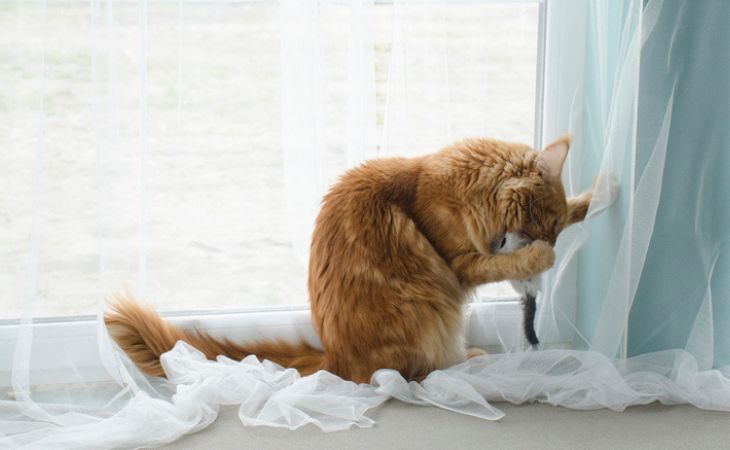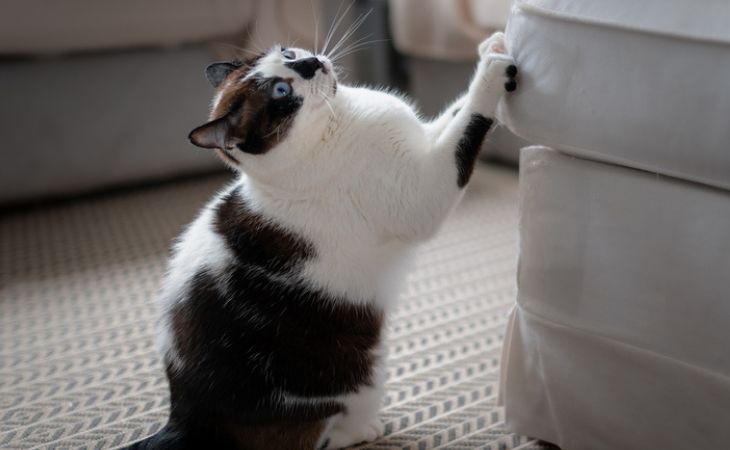While cats are incredibly adorable, some of their habits can be difficult for pet parents to manage. For example, scratching is completely natural for cats, but it can become problematic if they are not scratching the right place. Does your cat scratch everything with their claws? Are you tired of seeing your furniture get destroyed? In this article, Letsgetpet will provide you with helpful advice to prevent your cat from doing this.
Why does my cat scratch everything?
As mentioned earlier, scratching is completely normal and natural for cats. They do this to mark and define their territory. These marks are left to visually warn other cats that the area is already occupied. While clawing, cats also deposit pheromones, which are produced by their sweat and sebaceous glands. This olfactory marking also indicates their presence and helps deter intruders.
You may notice your cat do this when they want to maintain and care for their ever-growing claws. If their claws are not regularly maintained, they can:
- cause your cat to be in pain,
- make moving around uncomfortable for your cat,
- and in more extreme cases, cause infections.
One of the most efficient ways to avoid and prevent these issues is to file them down and remove the dead parts of the claw to make way for the new ones. Sometimes, cats claw things to relieve stress. If this is the case, it’s important to avoid punishing your cat. This can risk frustrating them or stressing them even more. Anxious cats can have destructive scratching behavior. Because of this, be careful with how you react in this situation.
To be able to defend themselves, explore their environment, and hunt better, cats need to sharpen their claws daily. They also often needs to stretch when they wake up. Stretching is essential to prevent and avoid the overheating of their muscles and tendons.
How do I prevent my cat from scratching everything?
Your cat’s well-being depends on their natural claws. However, you must teach them not to scratch everything around them, as this could cause them to ruin all your belongings. For example, it’s important to teach your cat from an early age not to scratch your furniture. Teach them by speaking to them with a firm “no” and instead place them in front of the an object that is specifically designed for scratching. If your cat uses the scratching post, for example, praise them and reward them with treats. There are many other tricks you can use to prevent feline scratching, especially when your cat is already an adult.
Trim your cat’s claws
Cats can involuntarily scratch things when they jump from one spot to another, or when they run. This generally happens when their claws are too long. If this is the case, the best solution is to trim their claws. Simply trim the pointy end in order to limit the amount of destruction they can cause. Ideally, you should do this frequently and as early as possible to get your cat used to the procedure. Starting early will also teach your cat not to develop a fear of it.
If you do not know how to trim them or if your cat is reluctant to get their claws trimmed, do not hesitate to ask for advice from a vet during your visits. They will show you how to trim your cat’s claws safely.
You might find this article helpful: How to trim your cat’s claws
Protect your furniture
If your cat continues to ruin your furniture with their claws, consider investing in protective covers for your couches or sofas. These will protect your furniture from feline scratching and can also be easily replaced if they are too ruined. If your cat scratches the same area very often, place some sticky material such as tape on the couch to deter them.
The use of materials that cats hate is also an excellent solution to keep them away, notably if you do not wish to buy objects that prevent cats from scratching. For example, you can place some aluminum foil or double-sided tape on furniture that your cat often scratches.
Should I use repellants?
To radically keep your cat away from certain areas or objects, many recommend the use of repellants to keep your cat from approaching them and ruining them with their claws. This can be dangerous, especially if the product contains toxic substances or things that your cat is allergic to. Instead, encourage your cat to scratch objects that specifically designed to be scratched.
Provide your cat with a cat scratching post
Cat scratchers are posts or planks that are designed for cats to scratch. They are often made out of wood and covered in a rough material. It’s also possible to invest in a cat tree. In addition to serving as a spot for your cat to scratch, these objects are ideal for your cat to climb and rest. These toys are an all-in-one that are very appreciated by cats.

Your cat doesn’t use their scratching post? We’ve got solutions!
Does your cat completely ignore your scratching post? There’s no need to panic. This is often the case for adult cats, who are less curious and harder to train than kittens.
Why doesn’t your cat use their scratching post?
The quality of your scratching post can be one of the reasons why your cat is not interested in it. Therefore, it’s best to choose cat scratchers with a texture that suits your cat’s tastes. Depending on your budget and their preferences, you can opt for a structure in cardboard, or a model that is covered in rope or carpet.
Some cats love clawing and scratching furniture because of where they are placed. Therefore, observe the different ways your cat marks their territory. This will give you an idea of which type of scratching post to buy and where to place it for optimal use. Lastly, invest in a cat scratcher with a minimum height of 36 inches. This will ensure that your cat can stretch with it.
Vertical scratching posts are very appreciated by felines because they look like tree trunks. It is often covered in plant-based rope that your cat can scratch and claw. It’s a structure that is both stable and ergonomic. The models in cardboard are more accessible in terms of price. However, they do not last very long, which is a disadvantage when it comes to the product’s value for money. When it comes to cat trees, they are perfect if you have the necessary means. If you like DIY projects, you can try building a scratching post by yourself. Just make sure that the structure is solid and stable enough for your cat to scratch safely.
Solutions to resolve this issue
To try to get your cat to use the scratching post, here are a few tips that you can use:
- place the scratching post in an area where your cat passes by often (not far from where they sleep, the couch, or their favorite spot),
- reward your cat when they scratch a cat scratcher,
- move the cat scratcher to position its definitive spot once your feline has gotten used to scratching there,
- ensure that the definitive spot is easily accessible and visible,
- avoid placing the scratching post close to the litter box or next to your cat’s food bowl.
You can rub valerian or dried catnip on the scratching post to attract your cat. These herbs have a strong and irresistible odor that most cats really enjoy.

